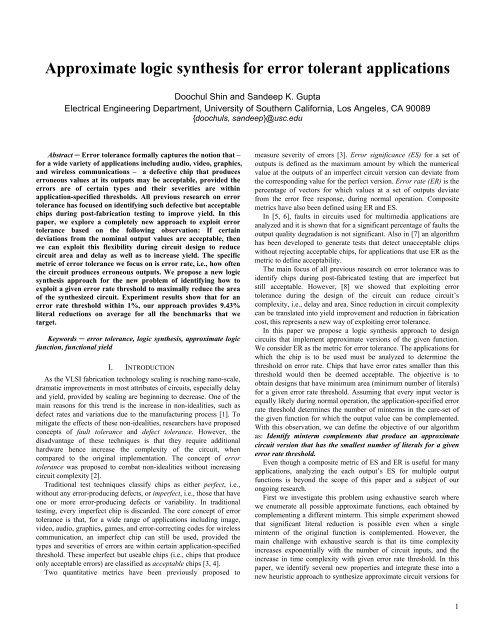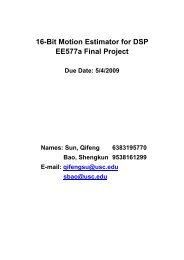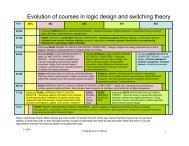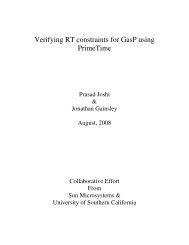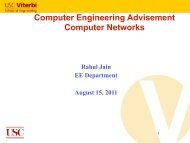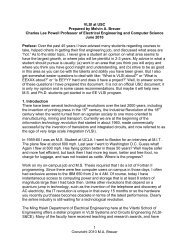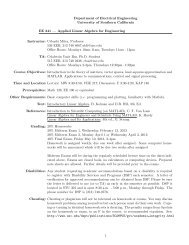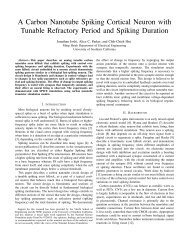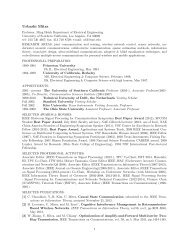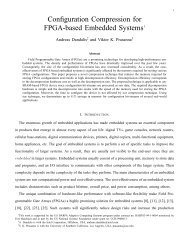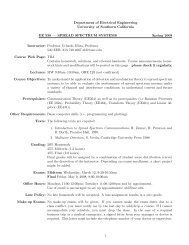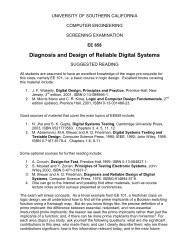Paper Title (use style: paper title) - University of Southern California
Paper Title (use style: paper title) - University of Southern California
Paper Title (use style: paper title) - University of Southern California
You also want an ePaper? Increase the reach of your titles
YUMPU automatically turns print PDFs into web optimized ePapers that Google loves.
Approximate logic synthesis for error tolerant applications<br />
Doochul Shin and Sandeep K. Gupta<br />
Electrical Engineering Department, <strong>University</strong> <strong>of</strong> <strong>Southern</strong> <strong>California</strong>, Los Angeles, CA 90089<br />
{doochuls, sandeep}@usc.edu<br />
Abstract ─ Error tolerance formally captures the notion that –<br />
for a wide variety <strong>of</strong> applications including audio, video, graphics,<br />
and wireless communications – a defective chip that produces<br />
erroneous values at its outputs may be acceptable, provided the<br />
errors are <strong>of</strong> certain types and their severities are within<br />
application-specified thresholds. All previous research on error<br />
tolerance has foc<strong>use</strong>d on identifying such defective but acceptable<br />
chips during post-fabrication testing to improve yield. In this<br />
<strong>paper</strong>, we explore a completely new approach to exploit error<br />
tolerance based on the following observation: If certain<br />
deviations from the nominal output values are acceptable, then<br />
we can exploit this flexibility during circuit design to reduce<br />
circuit area and delay as well as to increase yield. The specific<br />
metric <strong>of</strong> error tolerance we focus on is error rate, i.e., how <strong>of</strong>ten<br />
the circuit produces erroneous outputs. We propose a new logic<br />
synthesis approach for the new problem <strong>of</strong> identifying how to<br />
exploit a given error rate threshold to maximally reduce the area<br />
<strong>of</strong> the synthesized circuit. Experiment results show that for an<br />
error rate threshold within 1%, our approach provides 9.43%<br />
literal reductions on average for all the benchmarks that we<br />
target.<br />
Keywords ─ error tolerance, logic synthesis, approximate logic<br />
function, functional yield<br />
I. INTRODUCTION<br />
As the VLSI fabrication technology scaling is reaching nano-scale,<br />
dramatic improvements in most attributes <strong>of</strong> circuits, especially delay<br />
and yield, provided by scaling are beginning to decrease. One <strong>of</strong> the<br />
main reasons for this trend is the increase in non-idealities, such as<br />
defect rates and variations due to the manufacturing process [1]. To<br />
mitigate the effects <strong>of</strong> these non-idealities, researchers have proposed<br />
concepts <strong>of</strong> fault tolerance and defect tolerance. However, the<br />
disadvantage <strong>of</strong> these techniques is that they require additional<br />
hardware hence increase the complexity <strong>of</strong> the circuit, when<br />
compared to the original implementation. The concept <strong>of</strong> error<br />
tolerance was proposed to combat non-idealities without increasing<br />
circuit complexity [2].<br />
Traditional test techniques classify chips as either perfect, i.e.,<br />
without any error-producing defects, or imperfect, i.e., those that have<br />
one or more error-producing defects or variability. In traditional<br />
testing, every imperfect chip is discarded. The core concept <strong>of</strong> error<br />
tolerance is that, for a wide range <strong>of</strong> applications including image,<br />
video, audio, graphics, games, and error-correcting codes for wireless<br />
communication, an imperfect chip can still be <strong>use</strong>d, provided the<br />
types and severities <strong>of</strong> errors are within certain application-specified<br />
threshold. These imperfect but <strong>use</strong>able chips (i.e., chips that produce<br />
only acceptable errors) are classified as acceptable chips [3, 4].<br />
Two quantitative metrics have been previously proposed to<br />
measure severity <strong>of</strong> errors [3]. Error significance (ES) for a set <strong>of</strong><br />
outputs is defined as the maximum amount by which the numerical<br />
value at the outputs <strong>of</strong> an imperfect circuit version can deviate from<br />
the corresponding value for the perfect version. Error rate (ER) is the<br />
percentage <strong>of</strong> vectors for which values at a set <strong>of</strong> outputs deviate<br />
from the error free response, during normal operation. Composite<br />
metrics have also been defined using ER and ES.<br />
In [5, 6], faults in circuits <strong>use</strong>d for multimedia applications are<br />
analyzed and it is shown that for a significant percentage <strong>of</strong> faults the<br />
output quality degradation is not significant. Also in [7] an algorithm<br />
has been developed to generate tests that detect unacceptable chips<br />
without rejecting acceptable chips, for applications that <strong>use</strong> ER as the<br />
metric to define acceptability.<br />
The main focus <strong>of</strong> all previous research on error tolerance was to<br />
identify chips during post-fabricated testing that are imperfect but<br />
still acceptable. However, [8] we showed that exploiting error<br />
tolerance during the design <strong>of</strong> the circuit can reduce circuit’s<br />
complexity, i.e., delay and area. Since reduction in circuit complexity<br />
can be translated into yield improvement and reduction in fabrication<br />
cost, this represents a new way <strong>of</strong> exploiting error tolerance.<br />
In this <strong>paper</strong> we propose a logic synthesis approach to design<br />
circuits that implement approximate versions <strong>of</strong> the given function.<br />
We consider ER as the metric for error tolerance. The applications for<br />
which the chip is to be <strong>use</strong>d must be analyzed to determine the<br />
threshold on error rate. Chips that have error rates smaller than this<br />
threshold would then be deemed acceptable. The objective is to<br />
obtain designs that have minimum area (minimum number <strong>of</strong> literals)<br />
for a given error rate threshold. Assuming that every input vector is<br />
equally likely during normal operation, the application-specified error<br />
rate threshold determines the number <strong>of</strong> minterms in the care-set <strong>of</strong><br />
the given function for which the output value can be complemented.<br />
With this observation, we can define the objective <strong>of</strong> our algorithm<br />
as: Identify minterm complements that produce an approximate<br />
circuit version that has the smallest number <strong>of</strong> literals for a given<br />
error rate threshold.<br />
Even though a composite metric <strong>of</strong> ES and ER is <strong>use</strong>ful for many<br />
applications, analyzing the each output’s ES for multiple output<br />
functions is beyond the scope <strong>of</strong> this <strong>paper</strong> and a subject <strong>of</strong> our<br />
ongoing research.<br />
First we investigate this problem using exhaustive search where<br />
we enumerate all possible approximate functions, each obtained by<br />
complementing a different minterm. This simple experiment showed<br />
that significant literal reduction is possible even when a single<br />
minterm <strong>of</strong> the original function is complemented. However, the<br />
main challenge with exhaustive search is that its time complexity<br />
increases exponentially with the number <strong>of</strong> circuit inputs, and the<br />
increase in time complexity with given error rate threshold. In this<br />
<strong>paper</strong>, we identify several new properties and integrate these into a<br />
new heuristic approach to synthesize approximate circuit versions for<br />
1
higher error rate thresholds.<br />
This <strong>paper</strong> is organized as follows. In the next section, we show<br />
the results <strong>of</strong> our exhaustive search experiments. In Section III, we<br />
develop several new properties to reduce the number <strong>of</strong> candidate<br />
minterms that can be complemented to reduce the number <strong>of</strong> literals.<br />
In Section IV, we propose our heuristic approach to identify<br />
minterms that can be complemented to maximally reduce the number<br />
<strong>of</strong> literals. Finally in Section V, we present experimental results for<br />
benchmark circuits and report the yield improvements provided by<br />
our approach.<br />
II. EXHAUSTIVE SEARCH TO FIND OPTIMAL MINTERM<br />
COMPLEMENTS<br />
A. Example <strong>of</strong> reducing literals in a circuit by<br />
complementing minterms <strong>of</strong> the original function.<br />
Definition 1) Minterm complement threshold (Ct): The<br />
maximum number <strong>of</strong> minterms in the care-set (on-set and <strong>of</strong>f-set) <strong>of</strong><br />
the Boolean function that can be complemented under the given error<br />
rate threshold.<br />
For example, for an n input function, if the error rate threshold is r,<br />
then we are allowed to complement up to Ct = r·2 n minterms in its<br />
care-set.<br />
x3x4<br />
00<br />
01<br />
11<br />
10<br />
x1x2<br />
00<br />
0<br />
0<br />
0<br />
0<br />
01<br />
0<br />
1<br />
1<br />
0<br />
(a)<br />
11<br />
(c: complemented minterms)<br />
0<br />
0<br />
1<br />
0<br />
10<br />
0<br />
1<br />
0<br />
0<br />
Figure 1. Literal reductions obtained by complementing a minterm.<br />
x3x4<br />
x3x4<br />
The cover in Figure 1(a) is the minimum sum-<strong>of</strong>-product (SOP)<br />
cover. Suppose Ct = 1. Then we can complement any one minterm<br />
from the original function. To reduce the number <strong>of</strong> literals from<br />
original minimum cover, we choose minterm x1x2x3x4to complement<br />
from 0 to 1. The minimum cover for this simplified function is shown<br />
in Figure 1(b). The complemented minterm expands the prime<br />
implicant (PI) x2xx 3 4 to 2 4 , x x expands x1x2x3x4 to x1xx 3 4and<br />
removes x1x2x 4 . This reduces the number <strong>of</strong> literals by 1, 1, and 3,<br />
respectively, with respect to the original PIs. Hence, the total literal<br />
reduction is six for this minterm complement, since removing a PI<br />
also reduces 1 literal in the “OR” part <strong>of</strong> SOP representation. A<br />
significant reduction in the number <strong>of</strong> literals can hence be expected<br />
by selecting 0 to 1 minterm complements that can expand many<br />
original PIs. With the same constraint <strong>of</strong> Ct = 1, Figure 1(c) shows an<br />
example where complementing a minterm from 1 to 0 reduces the<br />
00<br />
01<br />
11<br />
10<br />
00<br />
01<br />
11<br />
10<br />
x1x2<br />
x1x2<br />
00<br />
0<br />
0<br />
0<br />
0<br />
00<br />
0<br />
0<br />
0<br />
0<br />
01<br />
0<br />
1<br />
1<br />
0<br />
01<br />
0<br />
1<br />
1<br />
0<br />
(b)<br />
(c)<br />
11<br />
0<br />
c<br />
1<br />
0<br />
11<br />
0<br />
0<br />
1<br />
0<br />
10<br />
0<br />
1<br />
0<br />
0<br />
10<br />
0<br />
c<br />
0<br />
0<br />
number <strong>of</strong> literals. In this case PI x1x2x3x4can be removed, which<br />
reduces five literals from the original minimum cover.<br />
B. Exhaustive search to find a minterm complement for<br />
maximum literal reduction<br />
This sub-section presents the results <strong>of</strong> our exhaustive search to<br />
identify the minterm complements that reduce the greatest number <strong>of</strong><br />
literals for a given Ct. Each possible combination <strong>of</strong> Ct or fewer<br />
minterm complements produces one approximate version <strong>of</strong> the<br />
function. Hence, assuming Ct minterms have been complemented to<br />
generate each approximate function, we have C(2 n , Ct ) possible<br />
approximate functions, where n is the number <strong>of</strong> inputs <strong>of</strong> the<br />
function. (Note: C(p, q) denotes all combinations <strong>of</strong> q items selected<br />
from a given set <strong>of</strong> p items.) We synthesize each approximate<br />
function and count the number <strong>of</strong> literals in the synthesized circuit.<br />
For example, if Ct = 1 (i.e., error rate threshold is 1/2 n ), first we<br />
complement minterm (000…000) to obtain an approximate version <strong>of</strong><br />
the function, synthesize it, and count the number <strong>of</strong> literals in the<br />
circuit. This experiment is repeated for all single complements from<br />
minterm (000…000) to (111…111). We <strong>use</strong> two-level logic synthesis<br />
tool ESPRESSO-MV [9].<br />
250<br />
200<br />
150<br />
100<br />
50<br />
0<br />
Number <strong>of</strong> circuit versions<br />
0 to 1<br />
1 to 0<br />
580 590 600 610 620<br />
1000<br />
800<br />
600<br />
400<br />
200<br />
Number <strong>of</strong> circuit versions<br />
0 to1<br />
1 to 0<br />
0<br />
1340 1380 1420 1460<br />
Number <strong>of</strong> literals<br />
Number <strong>of</strong> literals<br />
(a) (b)<br />
Figure 2. Number <strong>of</strong> literals in different circuit versions when Ct = 1: (a)<br />
Z9sym.pla, and (b) sym10.pla.<br />
Figure 2 shows the histograms <strong>of</strong> number <strong>of</strong> literals in different<br />
circuit versions obtained in this manner for (a) Z9sym.pla (a 9-input,<br />
1-output function), and (b) sym10.pla (a 10-input, 1-output function),<br />
which are benchmark circuits from the two-level synthesis suite. The<br />
numbers <strong>of</strong> literals in the original minimum covers are 610 and 1470,<br />
respectively. We achieve 4.8% and 8.5% literal (area) reduction for<br />
Z9sym.pla and sym10.pla, respectively, when we complement a<br />
single minterm that reduces the number <strong>of</strong> literals by the maximum<br />
amount, compared to the minimum cover for the corresponding<br />
original function.<br />
One important observation from Figure 2 is that all approximate<br />
versions <strong>of</strong> circuits that have the smallest numbers <strong>of</strong> literals are<br />
obtained from approximate functions obtained by complementing a<br />
minterm in the <strong>of</strong>f-set (i.e., by a 0 to 1 complement). This is beca<strong>use</strong><br />
to reduce the number <strong>of</strong> literals by exploiting a 1 to 0 complement,<br />
we have to remove an existing PI. With one 1 to 0 complement, we<br />
can only remove at most one PI in the original minimum cover.<br />
However, a 0 to 1 complement can expand many PIs in the original<br />
minimum cover. Also, if an expanded PI covers all the minterms in<br />
another PI, then the PI that has been covered becomes redundant and<br />
hence can be removed from the minimum cover for approximate<br />
function. Figure 1(b) shows the removal <strong>of</strong> a PI made redundant by a<br />
0 to 1 complement. A similar reasoning also suggests that 0 to 1<br />
2
complements <strong>of</strong>ten provide greater reductions in number <strong>of</strong> literals<br />
for cases where we are allowed to complement multiple minterms <strong>of</strong><br />
the function.<br />
In Figure 2, we can also observe that several circuit versions have<br />
larger numbers <strong>of</strong> literals than the original minimum cover. There are<br />
two reasons for this: (i) a 0 to 1 minterm complement adds a new PI<br />
to the original minimum cover, and (ii) a 1 to 0 minterm complement<br />
reduces the size <strong>of</strong> PIs that were <strong>use</strong>d in the original minimum cover<br />
and this necessitates the <strong>use</strong> <strong>of</strong> multiple PIs, each with more literals.<br />
Such an exhaustive search can only be <strong>use</strong>d for circuits with small<br />
number <strong>of</strong> inputs and to select a small number <strong>of</strong> minterms to<br />
complement, since complexity grows exponentially with the number<br />
<strong>of</strong> inputs and increase in complexity with Ct. Hence, we perform<br />
exhaustive search only when Ct = 1 or 2 for most <strong>of</strong> the benchmarks<br />
to compare with the heuristic approach that we describe in Section IV.<br />
III. DETERMINISTIC PRUNE OF MINTERM COMPLEMENT<br />
CANDIDATES<br />
In the previous section, we quantified literal reductions obtained<br />
by exhaustively enumerating all possible approximations. From the<br />
results, we notice that 0 to 1 complements are typically more<br />
beneficial than 1 to 0 complements and suggested possible reasons<br />
for this phenomenon. In the rest <strong>of</strong> this <strong>paper</strong>, we will focus only on 0<br />
to 1 complements. In this section, we introduce some <strong>use</strong>ful<br />
properties to eliminate 0 to 1 complement candidates that cannot<br />
reduce the number <strong>of</strong> literals.<br />
Definition 2) Adjacent minterms: Consider two minterms mi and<br />
mj. mi and mj are said to be adjacent if the hamming distance between<br />
mi and mj is 1 in the sense that mi and mj differ only in one bit.<br />
For example, in a four-input function, minterms x1x2x3x4 and<br />
x1xxx 2 3 4are<br />
adjacent to each other.<br />
Definition 3) Minterm cluster (Mc): A minterm cluster is a set <strong>of</strong><br />
minterms complemented from the original function from 0 to 1 such<br />
that for any two minterms, mi and mj ∈ Mc, there exists a sequence<br />
<strong>of</strong> minterms (mi, mi1,, mi2,… ,miα, mj) where mi1,, mi2,… ,miα belong to<br />
Mc, and every pair <strong>of</strong> consecutive minterms in the sequence are<br />
adjacent.<br />
For developing properties, let us denote the set <strong>of</strong> all on-set<br />
minterms in the original function by a set Mo and the set <strong>of</strong> PIs newly<br />
generated by complementing the set <strong>of</strong> minterms Mc as PI(M c). Also,<br />
denote the set <strong>of</strong> minterms in a prime implicant PIj as M PIj.<br />
Property 1) Consider a 0 to 1 minterm complement mf. If MPIδ ∩<br />
Mo = φ, for all PI such that mf ∈ PIδ, then there exist other<br />
approximate versions <strong>of</strong> the original function with fewer literals and<br />
smaller sets <strong>of</strong> minterm complements that do not include the minterm<br />
com plement mf.<br />
Pro<strong>of</strong>) To cover mf in the new minimum cover, we need at least<br />
one PIδ. Since MPIδ ∩ Mo = φ , if we do not complement minterms<br />
that are only covered by PIδ, including mf, we can remove PIδs from<br />
the cover for the approximate function. This leads to a new circuit<br />
version with fewer literals and fewer minterm complements, beca<strong>use</strong><br />
without PIδ, the number <strong>of</strong> literals reduces and we complement fewer<br />
minterms from the original function.<br />
Hence, under the given minterm complement threshold, there<br />
exists another approximate circuit version with fewer literals and<br />
fewer minterm complements where we do not complement mf. □<br />
Above property shows us that if there exists a minterm<br />
complement mf and for all the PIδs for which mf ∈ PIδ don’t overlap<br />
with Mo, then we do not have to consider complementing mf from the<br />
original function. For example, in Figure 3(a), it is unnecessary to<br />
complement minterm x1x2x3x4 with x1x2x3x4 beca<strong>use</strong> when we<br />
complement both minterms, we need an additional PI x1xx 3 4to<br />
cover<br />
minterm x1x2x3x4 . Even though the minimum cover for the<br />
approximate function obtained by complementing both minterms has<br />
fewer literals than the original minimum cover, there exists another<br />
approximate version <strong>of</strong> circuit, obtained by complementing only<br />
1 2 3 4 , x x x x which has fewer literals and fewer minterm complements.<br />
Corollary 1) If MPIδ ∩ Mo = φ, for all PIδ ∈ PI(Mc), then the<br />
number <strong>of</strong> literals in the minimum cover <strong>of</strong> approximate function<br />
obtained by complementing Mc is greater than the number <strong>of</strong> literals<br />
in the original minimum cover.<br />
Pro<strong>of</strong>) For Mc ∪ Mo, the original minimum cover is still the<br />
minimum cover for Mo beca<strong>use</strong> MPIδ ∩ Mo = φ , for all PIδ ∈ PI(Mc). Since we need additional PIs to cover Mc in addition to the PIs that<br />
cover Mo, the literals for these additional PIs are added to the number<br />
<strong>of</strong> literals in the original minimum cover. □<br />
x1x2<br />
x3x4<br />
00<br />
01<br />
11<br />
10<br />
00<br />
0<br />
0<br />
0<br />
0<br />
01<br />
0<br />
1<br />
1<br />
0<br />
11<br />
0<br />
c<br />
1<br />
0<br />
10<br />
0<br />
0<br />
0<br />
0<br />
x3x4<br />
x1x2<br />
00<br />
01<br />
11<br />
10<br />
00<br />
c<br />
c<br />
0<br />
0<br />
01<br />
(a) (b)<br />
Figure 3. Examples <strong>of</strong> minterm complement candidates.<br />
Figure 3 (b) shows that complementing Mc =<br />
{ x1x2x3x4, 1 2 3 4 , x x x x 1 2 3 4 } x x x x cannot reduce the number <strong>of</strong><br />
literals from the original minimum cover and Mc requires additional<br />
PI to cover. Conversely, for a Mc to reduce number <strong>of</strong> literals from<br />
original minimum cover, there must exist PIδ ∈ PI(Mc) such that<br />
MPIδ ∩ Mo ≠ φ (i.e., at least one PI in PI(Mc) must overlap with Mo). Corollary 2) Let d be the hamming distance between a 0 to 1<br />
minterm complement mf and a on-set minterm in Mo that is at the<br />
minimum distance from mf. For the new approximate function<br />
obtained by complementing mf to reduce the number <strong>of</strong> literals in the<br />
min imum cover, d ≤ log2(Ct+1). Pro<strong>of</strong>) Let mc be a closest on-set minterm in Mo to mf. Suppose we<br />
complement mf to reduce literals from the original minimum cover.<br />
For mf to reduce literals from the original minimum cover, ∃ PIδ such<br />
that mf∈ MPIδ and MPIδ ∩ Mo ≠ φ . The prime implicant PIδ that<br />
contains mf, overlaps with Mo and contains the smallest number <strong>of</strong><br />
minterm complements is the PI which consists <strong>of</strong> literals common to<br />
minterms mf and mc. All the minterms in this PI must have the literals<br />
common to mf and mc and the distance from each minterm in the PI<br />
(except for mf) to mc must be smaller than the distance from mf to mc. Since we assume that mc is the on-set minterm in Mo that is the<br />
closest to mf, all the other minterms except mc in the PI are not in Mo. This in turn means all these are <strong>of</strong>f-set minterms for the original<br />
c<br />
0<br />
1<br />
0<br />
11<br />
0<br />
0<br />
1<br />
0<br />
10<br />
0<br />
0<br />
0<br />
0<br />
3
function. Since to complement all minterms in the PI except m c<br />
requires 2 d -1 complements, 2 d -1 ≤ C t. Hence, we see that d ≤<br />
log 2(C t+1). □<br />
x3x4<br />
00<br />
01<br />
11<br />
10<br />
x1x2<br />
00<br />
0<br />
0<br />
0<br />
0<br />
01<br />
0<br />
1<br />
1<br />
0<br />
(a)<br />
11<br />
0<br />
0<br />
1<br />
0<br />
10<br />
0<br />
0<br />
0<br />
0<br />
Figure 4. Candidate minterm flips when Ct = 1: (a) All the minterms in<br />
CM, (b) Minterms that can expand the original PIs.<br />
x3x4<br />
Figure 4(a) shows the possible minterm complements when C t = 1.<br />
The shaded <strong>of</strong>f-set minterms are the ones for which d ≤ log2(C t +1)<br />
(note that d is a non-negative integer). Only the <strong>of</strong>f-set minterms<br />
among these candidates can reduce the number <strong>of</strong> literals compared<br />
to the original minimum cover when Ct = 1. We can try different<br />
combinations <strong>of</strong> Ct or fewer complements out <strong>of</strong> these candidates and<br />
synthesize each approximate function to obtain the approximate<br />
version <strong>of</strong> circuit that has the minimum number <strong>of</strong> literals, for the<br />
given Ct. Assuming we complement all the possible C t complements<br />
for the approximate function with above proprieties, we can only<br />
consider C(CM, Ct) cases to complement, where CM is the set <strong>of</strong> <strong>of</strong>fset<br />
minterms such that, for each minterm, d ≤ log 2(C t +1).<br />
IV. APPROXIMATE LOGIC SYNTHESIS BY ASSISTING<br />
EXPANSIONS<br />
With the observations in Section II and properties derived in<br />
Section III, we identify the facts that 0 to 1 complements that are<br />
within a particular hamming distance <strong>of</strong> the minterms in the original<br />
function are possible candidate minterms to complement to reduce<br />
the number <strong>of</strong> literals from the original minimum cover. However, a<br />
search algorithm that considers C(CM, Ct) approximate functions still<br />
has exponential worst-case run-time complexity in the number <strong>of</strong><br />
function inputs, n, and a significant complexity with Ct.<br />
In this section, we propose a heuristic approach to select 0 to 1<br />
minterm complements to find an approximate circuit version that has<br />
the minimum number <strong>of</strong> literals for a given value <strong>of</strong> Ct. Among the<br />
minterms in CM, the minterms that we focus on are the minterms<br />
that can assist expanding PIs in the original minimum cover. The<br />
main reason is beca<strong>use</strong> when we complement only minterms from 0<br />
to 1 that can expand one or more PIs in the original minimum cover,<br />
the given minimum cover <strong>of</strong> the corresponding approximate function<br />
is guaranteed to have a smaller number literals than the minimum<br />
cover for the original function. On the other hand, complementing<br />
minterms in CM that cannot expand any PI in the original cover<br />
requires new PIs to cover the complemented minterms which may<br />
increase the total number <strong>of</strong> literals. In some cases, complementing<br />
minterms that cannot expand any original PI can also reduce the total<br />
number <strong>of</strong> literals by producing a different cover for the original<br />
function if minterm complements are in CM (minterm complements<br />
that can expand one or more original PIs are also in CM). In this case,<br />
the total literal reduction is the difference between the increase in the<br />
number <strong>of</strong> literals due to the new PIs that cover minterm<br />
complements and the decrease in the number <strong>of</strong> literals due to the <strong>use</strong><br />
00<br />
01<br />
11<br />
10<br />
x1x2<br />
00<br />
0<br />
0<br />
0<br />
0<br />
01<br />
0<br />
1<br />
1<br />
0<br />
(b)<br />
11<br />
0<br />
0<br />
1<br />
0<br />
10<br />
0<br />
0<br />
0<br />
0<br />
<strong>of</strong> a different cover for the original function. Figure 4 shows the<br />
candidate minterm complements when we consider (a) all minterms<br />
in CM for Ct = 1, and (b) the candidate minterms that can expand one<br />
or more PI in the original cover, for the case where Ct = 1. Typically,<br />
the latter set contains much fewer candidate minterms. Our heuristic<br />
exploits the fact that in most cases, a combination <strong>of</strong> minterm<br />
complements that can assist PI expansions can provide an<br />
approximate circuit version with the minimum number <strong>of</strong> literals at<br />
given Ct. However, there exist some original functions where<br />
minterm complements that do not expand any PI in the given original<br />
function minimize the number <strong>of</strong> literals for a given Ct. Based on above observations, we develop procedures to enumerate<br />
all the possible expansions for the original PIs and for identifying<br />
approximate circuit versions with the minimum number <strong>of</strong> literals for<br />
a given Ct.<br />
Definition 3) Minterm set to expand original PIs (MSEOP): A<br />
set containing all <strong>of</strong>f-set minterms that prevent expanding one or<br />
mo re PIs in a certain direction.<br />
Since a PI can expand by eliminating different literals in the PI,<br />
multiple MSEOPs can exist for a PI. For example, in Figure 4(b),<br />
{ x1x2x3x4}, { x1x2x3x4, x1x2x3x 4},<br />
and { x 1xxx 2 3 4, xxxx 1 2 3 4}<br />
are a<br />
few different MSEOPs that each expand (by removing one literal) the<br />
PI x1x2x4in the original cover. We first enumerate all MSEOPs that<br />
can expand PIs in the original minimum cover to identify the MSEOP<br />
that leads to an approximate circuit version for a given Ct. Let us<br />
denote the cardinality <strong>of</strong> MSEOP by |MSEOP|. If |MSEOP| ≤ Ct, we<br />
store the original PI, the expanded PI, and the number <strong>of</strong> literals<br />
reduced by the expansion to a list, L(MSEOP). After searching all the<br />
PIs that can expand in the given Ct, the list contains the information<br />
about PIs that can be expanded by complementing MSEOPs. Figure 5<br />
shows the procedure Generate-list.<br />
//Generate-list ( )<br />
begin<br />
foreach PI in the original minimum cover i,<br />
foreach possible expansion <strong>of</strong> PIi j,<br />
if |MSEOPij| ≤ C t, then add info about PI ij to expansion<br />
list L(MSEOPij)<br />
end<br />
Figure 5. Procedure to generate list <strong>of</strong> MSEOP that can expand PI.<br />
//Generate-union-list (MSEOPi)<br />
begin<br />
foreach L(MSEOP) j,<br />
if | MSEOPi ∪ MSCOP j | ≤ C t,<br />
Merge L(MSEOP i) and L(MSEOP i) into L(MSEOP i<br />
MSEOP j)<br />
Generate-union-list (MSEOPi ∪ MSEOP j)<br />
end<br />
Figure 6. Procedure for generating union list for union MSEOP.<br />
Lists from Generate-list consider MSEOPs that can expand at least<br />
one PI in the original minimum cover. We can consider<br />
complementing union <strong>of</strong> multiple MSEOPs, such that |MSEOPi ∪<br />
MSEOPj ∪ MSEOPk … | ≤ Ct. ∪<br />
4
Figure 6 shows the procedure for generating such an union list.<br />
These generated lists contain information regarding the literal<br />
reduction when complementing an MSEOP or union <strong>of</strong> multiple<br />
MSEOPs. However, for accurately estimating the literal reduction, we<br />
have to examine PIs after expansion. This is beca<strong>use</strong>, in many cases,<br />
the expanded PIs can make other PIs redundant and counting the<br />
literals <strong>of</strong> these redundant PIs can underestimate the total reduction in<br />
the number <strong>of</strong> literals. Hence for accurate estimation <strong>of</strong> literal<br />
reduction, we develop and <strong>use</strong> following properties.<br />
Let us denote two different PIs (PI1 and PI 2) and a MSEOP for PI 1,<br />
MSEOP1, and a MSEOP for PI 2, MSEOP 2. Also denote the number <strong>of</strong><br />
literals reduced by expanding PI1 using MSEOP 1 by l 1 and PI 2 using<br />
MSEOP2 by l 2.<br />
Property 2) If MSEOP1 = MSEOP 2 and the PIs after expanding PI 1<br />
and PI2 are not identical, then the number <strong>of</strong> literals reduced by<br />
co plementing MSEOP1 is (l 1 + l 2).<br />
m Property 3) If MSEOP1 = MSEOP 2 and the PIs after expanding PI 1<br />
and PI2 are identical, then the number <strong>of</strong> literals reduced by<br />
com plementing MSEOP1 is: l1 + (all the literals in PI2) + 1.<br />
Property 4) If MSEOP1 ⊃ MSEOP2 and PI1 = PI2, then the number<br />
<strong>of</strong> literals reduced by complementing MSEOP1 ( ⊃ MSEOP2) = l1. Property (2) shows that if the MSEOP is the same for the different<br />
PIs, we add the literal reduction for the two PIs, if no PI becomes<br />
redundant after expansion. In Property (3), the number <strong>of</strong> reduced<br />
literals in PIs that become redundant is added to the total literal<br />
reduction estimation. Property (4) prevents overestimating the<br />
number <strong>of</strong> literals when multiple MSEOPs exist for the same PI, and<br />
one <strong>of</strong> the MSEOPs is a superset <strong>of</strong> the other. In such case, expanded<br />
PI obtained by the superset MSEOP is only the PI that is counted for<br />
computing literal reduction. Our list generating procedure and literal<br />
estimating properties provide tight estimation <strong>of</strong> the lower bound on<br />
literal reduction by complementing certain MSEOP and union <strong>of</strong><br />
MSEOPs.<br />
V. EXPERIMENTAL RESULTS<br />
A. Comparison <strong>of</strong> assisting expansion heuristic and<br />
exhaustive search<br />
To show the near-optimality and efficiency <strong>of</strong> our heuristic, we<br />
performed exhaustive search for six benchmark circuits. The results<br />
can be obtained only for Ct = 1 and 2 under our experimental<br />
environment due to the high time complexity <strong>of</strong> the exhaustive search.<br />
The experiments were performed on a 2.66 Ghz quad core Intel Xeon<br />
processor with 2 GB <strong>of</strong> main memory. For the sum <strong>of</strong> runtime for 11<br />
cases, assisting expansion is 87.43 times faster than exhaustive search.<br />
Also the percentage difference in number <strong>of</strong> literals between the two<br />
approaches is 2.27%, on average.<br />
From Table 1, we see that multiple output benchmarks have<br />
greater difference in the numbers <strong>of</strong> literals between the exhaustive<br />
and heuristics than single output benchmarks. This is beca<strong>use</strong> for<br />
multiple output functions, our heuristic partitions the function into<br />
single output functions and generates input and output relationship<br />
for each output separately. After partitioning the function, we select<br />
minterm complements that can reduce the number <strong>of</strong> literals for each<br />
single output function. The minterm complements that have the<br />
greatest total estimated value <strong>of</strong> literal reductions for separate output<br />
functions is selected. However, above heuristic for multiple output<br />
functions does not take into account multiple output implicants, i.e.,<br />
implicants that have output value <strong>of</strong> 1 for more than one output [13].<br />
Table 1. The numbers <strong>of</strong> literals and runtimes.<br />
Benchmark Ct<br />
# <strong>of</strong> literals<br />
Exhaustive Heuristic<br />
Runtime(sec)<br />
Exhaustive Heuristic<br />
Z9sym 1 581 581 1.18 0.32<br />
(9,1, 610) 2 554 564 81.94 1.20<br />
sym10 1 1344 1345 6.99 6.39<br />
(10, 1, 1470) 2 1290 1290 947.32 26.40<br />
rd73 1 870 886 0.74 0.24<br />
(7, 3, 903) 2 845 866 46.86 2.73<br />
clip 1 763 777 8.08 0.18<br />
(9, 5, 793) 2 745 759 2162.40 0.25<br />
sao2<br />
(10, 4, 496)<br />
1 449 482 6.50 0.12<br />
5xp1 1 329 339 0.92 0.08<br />
(5, 7, 347) 2 300 314 60.35 0.10<br />
(Legend: # <strong>of</strong> I/Ps, # <strong>of</strong> O/Ps, number <strong>of</strong> literals in the original function.)<br />
B. Literal reductions for benchmark circuits<br />
We <strong>use</strong>d the heuristic described in Section IV to identify minterm<br />
complements that maximally reduce the number <strong>of</strong> literals for various<br />
values <strong>of</strong> Ct. We synthesized seven benchmark circuits from the twolevel<br />
synthesis suite that implement arithmetic functions since the<br />
idea <strong>of</strong> error tolerance has been shown to be applicable to datapath<br />
functions. To calculate the number <strong>of</strong> literals in each approximate<br />
version <strong>of</strong> the circuit, minterms selected by our heuristics are<br />
complemented in the original minimum cover to obtain an<br />
approximate cover, and two-level synthesis is performed. For each<br />
circuit, we perform above experiment for Ct = 1, 2, 4, 8. Since error<br />
rate threshold is Ct / 2 n for a given Ct, where n is number <strong>of</strong> inputs,<br />
identical Ct values corresponds to different error rate thresholds for<br />
different circuits. Typically, as the number <strong>of</strong> circuit inputs increases,<br />
larger literal reduction is achieved for the same error rate threshold.<br />
This occurs beca<strong>use</strong> the same error rate threshold allows<br />
exponentially larger number <strong>of</strong> minterm complements for a circuit<br />
with larger number <strong>of</strong> inputs. The results in Figure 7 show that, on an<br />
average, for an error rate threshold <strong>of</strong> 0.2% we achieve 3.75% literal<br />
reduction, and for an error rate threshold <strong>of</strong> 1% we achieve 9.43 %<br />
literal reduction.<br />
% reduction in literals<br />
30<br />
20<br />
10<br />
0<br />
0.000 0.005 0.010 0.015 0.020 0.025 0.030<br />
error rate<br />
Figure 7. Literal reduction for different error rates.<br />
rd73(7/3/903)<br />
clip(9/5/793)<br />
sao2(10/4/496)<br />
5xp1(7/10/347)<br />
Z9sym(9/1/610)<br />
sym10(10/1/1470)<br />
t481(16/1/5233)<br />
(legend: #<strong>of</strong> inputs/#<strong>of</strong> outputs/number <strong>of</strong> literals in original function.)<br />
C. Functional Yield improvement due to literal reduction<br />
We <strong>use</strong> the negative binomial yield model [17] to estimate<br />
functional yield improvement due to circuit area reduction that we<br />
calculated from the heuristic. Since we don’t have any information<br />
5
egarding manufacturing process, first we assume the yield <strong>of</strong> the<br />
original circuit is 0.7 and the clustering factor (α) is 4, for all the<br />
benchmark circuits. These assumptions enable us to calculate the<br />
value <strong>of</strong> defect density for the manufacturing process. Functional<br />
yield is then calculated using above defect density and the reduced<br />
area <strong>of</strong> approximately synthesized circuits. Since the circuit size is<br />
smaller then original circuit, number <strong>of</strong> defect in the circuit is smaller<br />
then original circuit that we can expect the functional yield<br />
improvement <strong>of</strong> the circuit. Table 2 shows the result <strong>of</strong> the<br />
experiment for different benchmarks. On average, we obtain 3.26%<br />
yield improvement with 1% error rate threshold and 4.35% yield<br />
improvement with 2% error rate threshold.<br />
Table 2. Yield improvement assuming circuit area is proportional to<br />
number <strong>of</strong> literals.<br />
Benchmarks Original<br />
Error rate = 0.01 Error rate = 0.02<br />
Approximate<br />
%<br />
improved Approximate<br />
%<br />
improved<br />
Z9sym 0.7 0.726 3.77 0.754 7.72<br />
sym10 0.7 0.738 5.42 0.738 5.42<br />
clip 0.7 0.716 2.35 0.726 3.74<br />
rd73 0.7 0.704 0.64 0.71 1.41<br />
sao2 0.7 0.757 8.09 0.757 8.09<br />
t481 0.7 0.705 0.77 0.705 0.77<br />
5xp1 0.7 0.713 1.79 0.723 3.31<br />
Yield improvement obtained by approximate synthesis grows with<br />
the defect density. In addition to assuming original yield as 0.7 for<br />
above experiment, we also recalculate yield improvements by<br />
assuming the original yield values as being 0.9, 0.5, 0.3, and 0.1 and<br />
measure the yield improvements with approximate logic synthesis.<br />
The decrease in original yield represents the increase in defect density.<br />
The results show that the % improvement in yield increase drastically<br />
as original yield decreases. This means that for the high defect<br />
density, we can expect huge % yield improvements using<br />
approximate logic synthesis. Figure 8 shows the yield improvement<br />
for different values <strong>of</strong> yield for the original design. Since the main<br />
objective <strong>of</strong> error-tolerance technique is to combat yield decrease due<br />
to increasing defect densities in future nano-scale fabrication<br />
processes, these curves clearly show that as the problem <strong>of</strong> yield<br />
decrease become more serious, our technique becomes more <strong>use</strong>ful.<br />
% improvement in yield<br />
30<br />
20<br />
10<br />
0<br />
0.9 0.7 0.5 0.3 0.1<br />
Yield for original design<br />
(a)<br />
% improvement in yield<br />
40<br />
30<br />
20<br />
10<br />
0<br />
0.9 0.7 0.5 0.3 0.1<br />
Yield for original design<br />
(b)<br />
Figure 8. Yield improvement: (a) Z9sym and (b) sym10 for different<br />
original yield values (error rate threshold = 0.01).<br />
VI. CONCLUSIONS<br />
In this <strong>paper</strong>, we present a new logic synthesis approach for error<br />
tolerant applications. The major contributions <strong>of</strong> this <strong>paper</strong> are (i)<br />
Proposing the idea <strong>of</strong> using error tolerance threshold during the<br />
design phase and demonstrating that it can provide dramatic<br />
improvements in chip cost and yield. On average, a 0.2% error rate<br />
threshold can reduce the number <strong>of</strong> literals by more than 3.75% and a<br />
1% error rate threshold can reduce the number <strong>of</strong> literal by 9.43%. (ii)<br />
Derivation <strong>of</strong> properties that eliminate large number <strong>of</strong> 0 to 1<br />
complements that cannot reduce the number <strong>of</strong> literals for a given<br />
original minimum cover. (iii) Development <strong>of</strong> a heuristic approach<br />
that is practically <strong>use</strong>able for larger circuits and high values <strong>of</strong> Ct and<br />
demonstration <strong>of</strong> the fact that our heuristic is near-optimal for all<br />
cases that we have tried. (iv) Calculation <strong>of</strong> the yield improvement<br />
using our technique and the demonstration that yield improvement<br />
becomes more significant as the original yield decreases.<br />
This work foc<strong>use</strong>d on synthesis <strong>of</strong> approximate two-level circuits<br />
starting with a given logic function. Since most <strong>of</strong> the well known<br />
multi-level synthesis heuristics factorize the function using boolean<br />
or algebraic division [11, 12], for some cases, a small number <strong>of</strong><br />
literals in the two-level SOP representation does not mean a small<br />
number <strong>of</strong> literals in the factored form or small area after technology<br />
mapping in multi-level synthesis. To find minterm complements that<br />
can reduce area and delay <strong>of</strong> multi-level circuits is a subject <strong>of</strong> our<br />
ongoing research. We are also developing methods to maximally<br />
simplify a given implementation <strong>of</strong> a circuit for implementation at a<br />
given value <strong>of</strong> Ct.<br />
VII. REFERENCES<br />
[1] International Technology Roadmap for Semiconductors (ITRS)<br />
2003 [Online]. http://public.itrs.net/Files/2003ITRS/Home2003.htm<br />
[2] M. A. Breuer and S. K. Gupta, “Intelligible testing,” In Proc Int’l<br />
Workshop on Microprocessor Test and Verification, 1999.<br />
[3] M. A. Breuer, “Intelligible test techniques to support error<br />
tolerance,” In Proc. Asian Test Symposium, 2004, pp. 386- 393.<br />
[4] M. A. Breuer, S. K. Gupta, and T. M. Mak, “Defect and errortolerance<br />
in the presence <strong>of</strong> massive numbers <strong>of</strong> defects,” IEEE<br />
Design and Test Magazine, 21, pp. 216-227, May 2004.<br />
[5] I. S. Chong and A. Ortega, “Hardware testing for error tolerant<br />
multimedia compression based on linear transforms,” In Proc.<br />
Defect and Fault Tolerance Conference, 2005, pp. 523- 531.<br />
[6] H. Chung and A. Ortega, “Analysis and testing for error tolerant<br />
motion estimation,” In Proc. Defect and Fault Tolerance conference,<br />
2005, pp. 514- 522.<br />
[7] S. Shahidi and S. K. Gupta, “ERTG: A test generator for error rate<br />
testing,” In Proc. International Test Conference, 2007, pp. 1-10.<br />
[8] D. Shin and S. K. Gupta, "A Re-design Technique for datapath<br />
modules in error tolerant applications," In Proc. Asian Test<br />
Symposium, 2008, pp. 431-437.<br />
[9] R. Rudell, “Multiple-Valued Logic Minimization for PLA<br />
Synthesis,” Technical Report, <strong>University</strong> <strong>of</strong>. <strong>California</strong>, Electronics<br />
Research Laboratory, Berkeley, 1986.<br />
[10] R. K. Brayton, A. Sangiovanni-Vincentelli, C. T. McMullen, and G.<br />
D. Hachtel, Logic Minimization Algorithms for VLSI Synthesis.<br />
Kluwer Academic Publishers, 1984.<br />
[11] R. K. Brayton, R. Rudell, A. Sangiovanni-Vincentelli, and A. R.<br />
Wang, “MIS: A multiple-level logic optimization system,” IEEE<br />
Trans. Computer-Aided Design, vol. CAD-6, pp. 1062–1081, Nov.<br />
1987.<br />
[12] A. Mishchenko, S. Chatterjee, and R. K. Brayton, "DAG-aware AIG<br />
rewriting: A fresh look at combinational logic synthesis,” In Proc.<br />
DAC, 2006, pp. 532-536.<br />
6
[13] G. D. Hachtel and F. Somenzi, Logic Synthesis and Verification<br />
Algorithms, Kluwer Academic Publishers, 2000.<br />
[14] S. Devadas, A. Ghosh, and K. Keutzer, Logic Synthesis, McGraw-<br />
Hill, 1994.<br />
[15] N. Jha and S. K. Gupta, Testing <strong>of</strong> Digital Systems, Cambridge<br />
<strong>University</strong> Press, 2003.<br />
[16] M. Abramovici, M. A. Breuer and A. D. Friedman, Digital Systems<br />
Testing and Testable Design, John Wiley and Sons, 1995.<br />
[17] I. Koren, Z. Koren, and C. H. Stepper, "A unified negative-binomial<br />
distribution for yield analysis <strong>of</strong> defect-tolerant circuits," IEEE<br />
Trans. Computers, vol.42, no.6, pp.724-734, Jun. 1993.<br />
7


